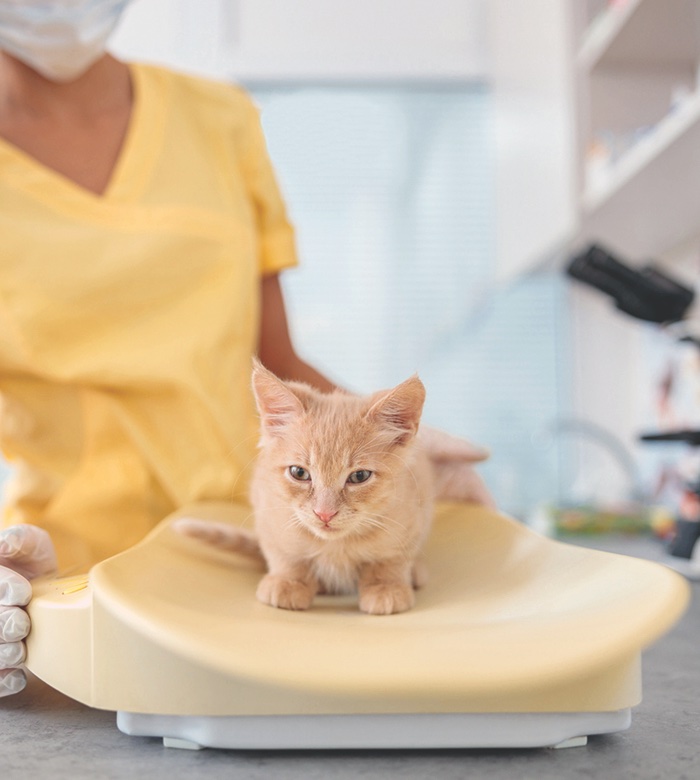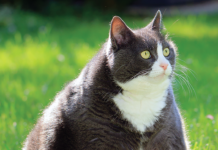There’s just no way around it: The average modern housecat is chunky. Carrying extra weight predisposes your cat to a wide range of health problems, which is bad for your cat and for your wallet. Getting our cats to a healthy weight and keeping them there is one of the most important things we can do as cat lovers to promote the health and wellbeing of our pet.
The Trouble with Cats
The problem with cats is that rapid weight loss and “starvation” diets are not safe for your cat.
When a cat stops eating and is not getting energy from food, their bodies start to break down fat. As fat stores are broken down, the fat must be processed by the liver. If the liver can’t keep up with the amount of fat coming through, the fat builds up and can cause a shutdown of all the important things that the liver needs to do for the body. This situation is called hepatic lipidosis, or “fatty liver syndrome.”
The most common symptoms are rapid weight loss, not eating, lethargy, and a yellowish tint to the cat’s skin and the whites of the eyes. It is extremely dangerous and can be fatal.
Hepatic lipidosis can happen to any cat who stops eating or is not eating enough to support their bodily functions, but overweight and obese cats are more at risk.
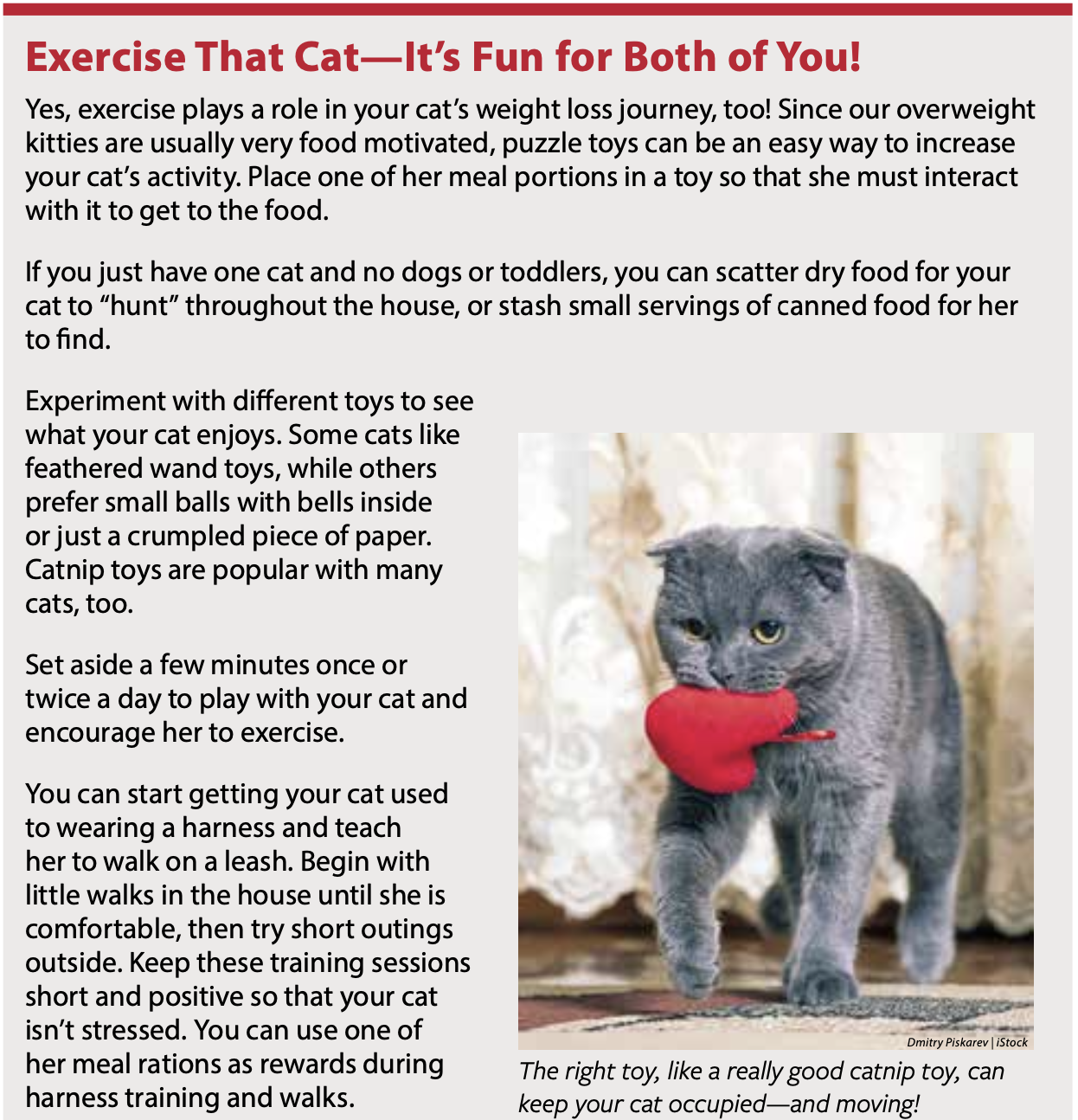
Start with Body Condition
To avoid fatty liver syndrome, we want to approach weight loss in cats slowly and with a concrete plan.
Your cat’s weight loss journey should start with a veterinary exam and probably some basic bloodwork. This allows your veterinarian to identify any underlying health problems that may be contributing to your cat’s obesity. Your veterinarian will also tell you your cat’s body condition score (BCS) and your cat’s target weight.
Body condition score (BCS) is a subjective judgment of where your cat falls on a scale of 1 to 9. A BCS of 1 is emaciated, and 9 is morbidly obese. An ideal BCS is 4 to 5. You have probably seen a poster on your veterinarian’s wall showing cats from the top and side and describing their condition.
A cat with an ideal BCS should have a visible waist both from the side and from above and, when you feel her rib cage, you should be able to feel individual ribs but under a thin layer of fat. The cat should also have little or no fat pad on her lower belly.
The target weight is a rough estimate of how much your cat will weigh when at an ideal body condition score. You and your veterinarian will both continually evaluate your cat’s condition as she loses weight, and the target weight may be adjusted over time.
If your cat is really overweight with a BCS of 8 or 9, your veterinarian will set several weight targets to use as milestones. This helps to encourage gradual weight loss while still allowing you to celebrate successes.
For example, if your cat weighs 25 pounds but should be 15 pounds, losing 10 pounds will take a long time. If you aim first for 22 pounds and then for 18 before setting your sights on 15 pounds, you can break the journey into smaller, more attainable steps.
Counting Calories
Don’t panic, but it’s time for some math. Start by figuring out how many calories your cat is currently eating each day. Dry food usually has the calories listed as kcal per cup of food, and canned food often is listed as calories per can. Include treats and toppers when calculating your cat’s current calorie intake.
Your veterinarian will help you determine how many calories your cat should be eating. There are a couple formulas that can be used to do this by hand, or you can use a calorie calculator for cats (more on that in a bit).
Resting energy requirement (RER) is the number of calories your cat needs just to keep his body going each day. RER = 30 x (body weight in kilograms) + 70.
That 25-pound cat weighs 11.36 kg. (Note: To find your cat’s weight in kilograms divide the pounds by 2.2.)
Therefore:
30 x 11.36 + 70 = 410 kcal per day
This formula doesn’t account for every cat. Kittens need significantly more calories for their relative size than adult cats, and intact cats usually need more calories than spayed and neutered cats. But for our chunky cats, this is a good general starting point to understand roughly how much a cat of their weight should be eating.
If your cat is currently eating more calories per day than his RER, your veterinarian may recommend starting by cutting back to that daily intake. In most cases, your veterinarian will compare the calories your cat is currently eating with the RER for his ideal weight, and gradually work toward that goal.
Cat Calorie Calculators
Several calorie calculators are available online to help with determining how much to adjust your cat’s calorie intake. One of the best known is the Pet Nutrition Alliance Calorie Calculator, which you can use for free at: https://petnutritionalliance.org/resources/calorie-calculator?type=cats
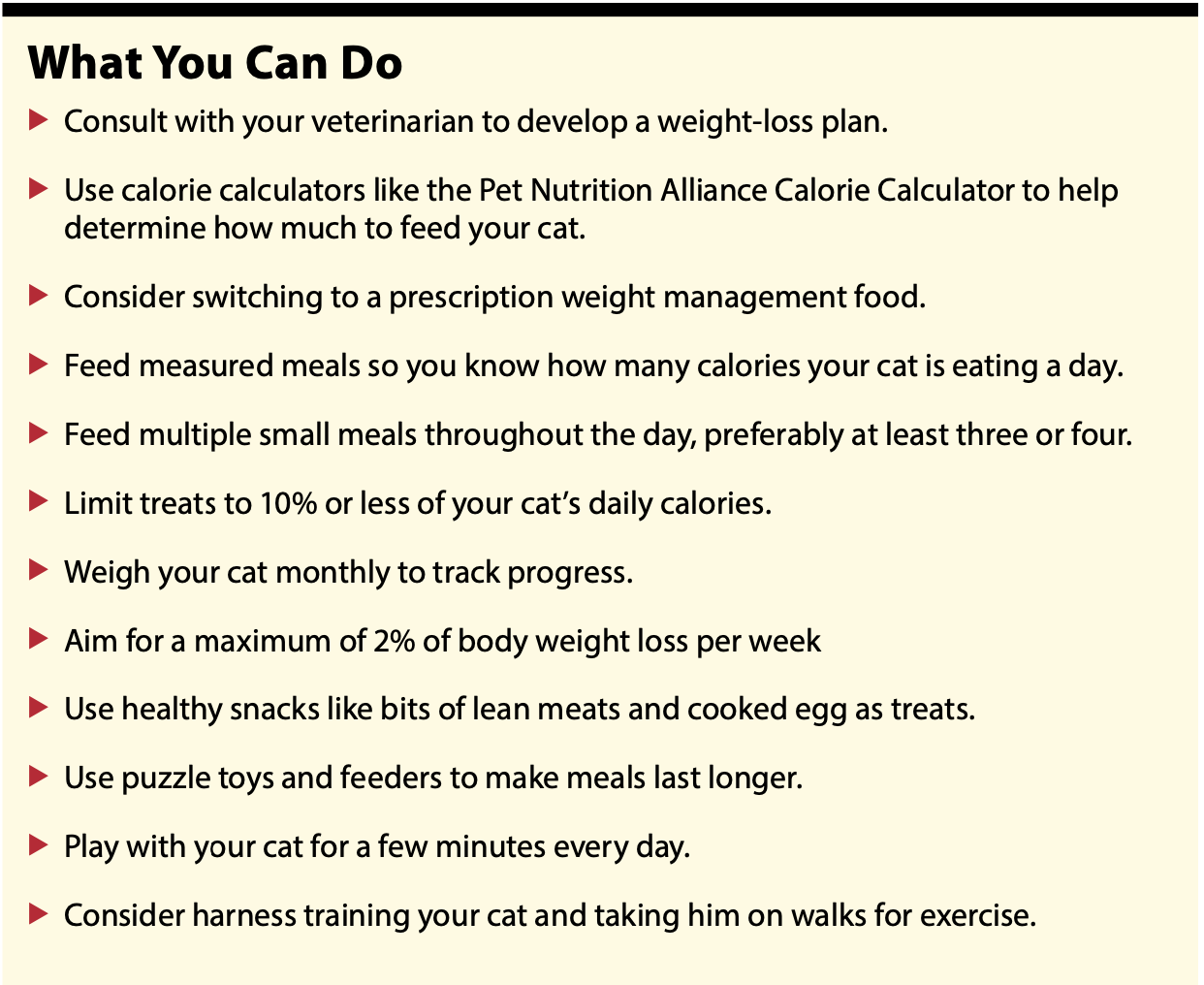
This tool lets you input your cat’s current weight and BCS, plus as much information as you have about his current diet and calorie intake.
How Slow is Slow?
So, what does gradual weight loss mean? Eileen Fatcheric, DVM (Cornell 1988), a practicing veterinarian in Syracuse, N.Y., offers an easy tip for owners to track their cat’s weight loss:
“I recommend no more than 2 percent of body weight loss per week. The easiest way for owners to calculate this is to convert the cat’s weight from pounds to ounces and calculate 2 percent of that,” she says.
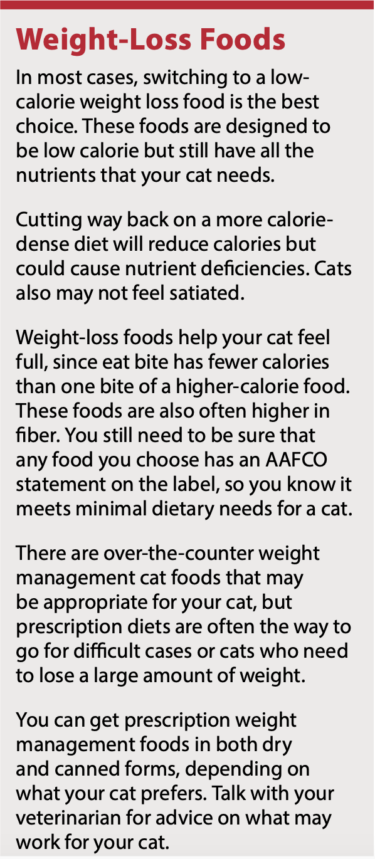 It is important for cats to lose weight gradually, as a rapid diet, especially if it includes fasting periods, can lead to hepatic lipidosis. The ideal rate of weight loss for cats is 0.5 to 2 percent of their body weight per week. So that 25-pound cat would ideally lose 2 to 8 ounces a week.
It is important for cats to lose weight gradually, as a rapid diet, especially if it includes fasting periods, can lead to hepatic lipidosis. The ideal rate of weight loss for cats is 0.5 to 2 percent of their body weight per week. So that 25-pound cat would ideally lose 2 to 8 ounces a week.
When looking monthly, an ideal rate of weight loss for most cats is 8 oz to 1 pound a month.
The higher your cat’s current body condition score is, the slower you will want to go with weight loss to prevent him from developing hepatic lipidosis. For those cats in the 8 to 9 range for BCS, aim for losing half a pound a month. For cats in the 6 to 7 range for BCS, you may be able to try for a full pound each month, but check with your veterinarian.
Weight Checks
Weigh your cat regularly—at least once a month—to make sure you are on the right track and she isn’t losing weight too quickly or too slowly.
Baby scales are a good size for most cats and can be purchased for as little as $30 to $40. Not in the budget right now? You can also use the old trick of weighing yourself holding your cat and then subtracting your weight, but this method is not as accurate.ν
Exercise That Cat—It’s Fun for Both of You!
Yes, exercise plays a role in your cat’s weight loss journey, too! Since our overweight kitties are usually very food motivated, puzzle toys can be an easy way to increase your cat’s activity. Place one of her meal portions in a toy so that she must interact with it to get to the food.
If you just have one cat and no dogs or toddlers, you can scatter dry food for your cat to “hunt” throughout the house, or stash small servings of canned food for her to find.
Experiment with different toys to see what your cat enjoys. Some cats like feathered wand toys, while others prefer small balls with bells inside or just a crumpled piece of paper. Catnip toys are popular with many cats, too.
Set aside a few minutes once or twice a day to play with your cat and encourage her to exercise.
You can start getting your cat used to wearing a harness and teach her to walk on a leash. Begin with little walks in the house until she is comfortable, then try short outings outside. Keep these training sessions short and positive so that your cat isn’t stressed. You can use one of her meal rations as rewards during harness training and walks.

